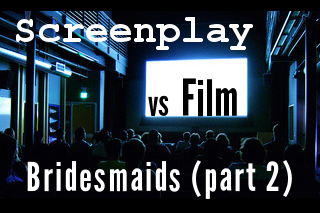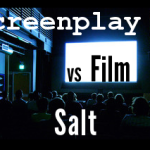Scribe Meets World has been taken over by a bridezilla or something, ’cause today is another Bridesmaids-themed post. First, I shared comedy screenwriting tips I learned by watching the low-brow blockbuster with a surprising amount of heart. Then I analyzed the differences between the Bridesmaids screenplay and the produced movie (well at least the unrated version sold on DVD). There were a LOT of differences, which means I had to break up the screenwriting tips I learned into two parts. Here’s the second one:
Screenwriting Tip #7: There’s subtext behind structure too
In the Bridesmaids screenplay, Annie met Officer Rhodes for the first time BEFORE she attended Lillian’s engagement party and embarrassed herself in front of a hundred strangers at a swanky private club. In romantic comedy parlance, it would definitely qualify as a “cute meet.” In the movie, Annie met Officer Rhodes when she was driving home AFTER the event. This simple switch takes their cute meet and enhances it. How?
It establishes their dynamic: after Annie gets herself into embarrassing and humiliating situations like her toast-off with Helen, she can rely on Officer Rhodes to help her pick up the pieces. This first meeting sets the stage for the rest of their relationship. It’s infused with underlying subtext–Officer Rhodes, will, unlike jerkwad Ted, offer Annie emotional support.
It’s a subtle change, but it makes a world of difference. It’s the kind of screenwriting choice which separates the professionals from the merely proficient.
Screenwriting Tip #8: Your hero should be worthy of your heroine
If romance plays a central role in your story, make sure the two lovers are worthy of each other. If your leading man is a badass, then make sure his leading lady is equally strong. (This is one of my many gripes with Indiana Jones and the Temple of Doom. Willie Scott is whiny and annoying. She’s not worthy of archeological bad boy Indiana Jones.)
In the screenplay draft of Bridesmaids I read, Officer Rhodes was portrayed as a decent guy, worthy of Annie’s affections. But that wasn’t always the case. In previous screenplay incarnations, he was more of a joke. Billy Mernit, story consult to Universal Studios, and author of the very helpful Writing the Romantic Comedy shares the inside scoop:
For example, the one element I can point to in my own notes as being a specific contribution to the movie (though it may ultimately have been a case of Great Minds Think Alike) is that I kept lobbying fiercely for a change in the conception of Officer Rhodes.
He started out as a caricature-like SNL character (he even had a Sean Connery-in-a-wheelchair crazy Irish dad stashed in his apartment at one point) and my argument was: No way! Rhodes has to be a good, decent, feet-on-the-ground regular guy kind of guy, or the whole arc of the story for Annie makes no sense.
We can’t perceive Annie’s mate-to-be as more pathetic than she is; he’s got to be more of a prize, someone she’s worthy of by the end. Subsequent drafts revised the character, and the casting, I thought, really cinched it.
More insider information can be found in the original post on Scott Meyers’s website, Go Into the Story. (If they’re not already there, you should definitely add Go Into the Story and Billy Mernit’s Blog, Living the Romantic Comedy, to your list of must-read screenwriting sites!)
I think the love story between Annie and Officer Rhodes was one reason for the movie’s box office success. (The realism of Annie’s friendship with Lillian is another.) If Officer Rhodes had remained a caricature, I don’t think the movie would have done nearly as well financially.
Ignoring this screenwriting tip can seriously hamper a movie’s box office mojo. Just look at the poor box office performance of Something Borrowed.
Screenwriting Tip #9: Be open to suggestions
A lot of aspiring screenwriters want to sell their material to Hollywood, but, at the same time, fear that their screenplay will be mangled by the studio system. That is a possibility, but the opposite can occur too. Your screenplay could be improved as it’s examined and refined by talented, experienced professionals. That’s what happened with Bridesmaids.
In the Bridesmaids script, Annie and the bridal party never got food poisoning. That’s right, the most memorable scene from the entire movie was not in the script at all. In fact, the bridesmaids eat at the restaurant AFTER they leave the fancy dress shop.
At the exclusive bridal store, Annie has a Christian Bale fantasy while trying on a bridesmaid’s dress in the dressing room. Helen makes fun of Annie’s “little boobies.” This scene was followed by the girls chatting at the restaurant, with Annie’s single gal status under heavy scrutiny. Funny, but nothing out of the ordinary.
Bridesmaids was produced under the auspices of Judd Apatow, writer and/or producer of The 40 Year Old Virgin, Anchorman, Knocked Up, and Superbad. Maybe you’ve heard of them?
Apatow suggested combining the low-brow effects of food poisoning with the high-brow backdrop of the exclusive dress shop. The result is a memorable, if very gross, comic set piece.
This scene is just the beginning…it gets even worse for the ladies, and funnier for the audience. This scene alone probably generated tons of word-of-mouth ticket sales. I bet screenwriters Annie Mumulo and Kristen Wiig were really glad they took Apatow’s suggestion!
Screewriting Tip #10: Steer clear of cliché
When you’re searching for set pieces for your comedy script, chances are, the first jokes you come up with are a rehash of comic tropes you’ve encountered hundreds of times before. When you’re revising your comedy screenplay, ask yourself a) do my jokes feel unique and b) does the humor stem from character?
In the screenplay draft of Bridesmaids, there were a few set pieces which were funny but not fresh. For example, at the end of the movie, the bridal party drives to a cabin where they think Lillian is hiding. En route, they get a flat tire. Annie saves the day by changing it, and there’s a bit of “yes, I’m a girl, and I can change a tire” humor. But the joke felt stale.
Even worse, it didn’t seem in keeping with Annie’s character. She was plucky, she was stubborn, but did I ever get the sense she knew about jacks and hydraulic power? No. It’s a joke more in keeping with Megan’s personality (and in fact, in this scene, Megan revealed she was a member of the Firebird Club).
In the movie version of Bridesmaids, the entire bridal party isn’t involved in searching for Lillian–just Annie and Helen. This was a good choice because the energy of the scene wasn’t diluted by too many characters. Annie seeks out Officer Rhodes’s assistance to find Lillian, which forced Annie and Rhodes together in a way which seemed organic, not just because the plot required it. For another example of how to naturally bring your leads together, read screenwriting tip #6 from this post on Notting Hill.
Fed up with Annie’s self-destructive behavior, Officer Rhodes ignores her, even when she violates every driving law known to man. He finally pays attention to her when she rear ends his car. This set piece was great (although some movie goers complained it was a little too long). It felt fresh, and Annie’s recklessness was in keeping with her character.
You may be surprised to know that in the script, the girls did have a rollickin’ bachelorette party in Vegas, complete with fancy hotel suites, raging night clubs, and sweaty strippers.
Typical Las Vegas–and totally cliché. All of that has been done before. Even the Hangover which was a comedic ode to Vegas, was smart enough to avoid a stereotypical strip club scene.
Realizing that keeping the Las Vegas hijinks would be a comedy disaster, the screenwriters made a bold choice. The bridal party didn’t go to Vegas at all.
They never got the chance because a combination of Scotch, pills, flying phobia, and insecurity caused Annie to ground the plane. A small window into her meltdown:
This set piece accomplishes a lot of things at once. First, it was hilarious, and ensured that Bridesmaids wouldn’t be compared to the Hangover…and found lacking. It was the perfect extension of Annie’s character, again showcasing her rivalry with Helen. Finally, it naturally launches the next plot development: Helen assuming responsibility for the bridal shower, thus setting the stage for the end of Act Two “all is lost” moment.
Here’s a nice summary from Billy Mernit:
The Vegas trip was in there for a long time, and didn’t get cut until the last draft I saw, in May of 2010. Maybe HANGOVER knocked the whole idea down a peg, but I always assumed it got dropped cause it a) helped the budget b) gave the movie a nice twist (i.e. they DON’T get your expected girls-night-out-in-vegas), c) gave Lillian a clear, no-argument reason for suggesting that Annie step down as Maid of Honor (i.e. You sabotaged the party!) and meanwhile d) the airplane set piece was getting bigger by the draft and served as a midpoint in its own right, and once the bridal shop sequence was in – Vegas actually seemed unnecessary.
Screenwriting Tip #11: There’s a fine line between funny and pathetic
In one of the Las Vegas scenes which got cut, after a lousy night, Annie hooks up with a frat boy. The next morning his girlfriend, Nicole, arrives at Annie’s motel room.
NICOLE
I couldn’t go anywhere last night. I tried calling you fifty times. And YOU? =You were what, hooking up with this fossil?!
ANNIE
First of all–
NICOLE
Shut the hell up, or I will kick your ass.
ANNIE
Okay, that is not nice.
NICOLE
And what are you, forty?
ANNIE
No, I’m in my low thirties…
(under her breath)
…and you could never kick my ass.
NICOLE
What did you say?!
ANNIE
(timid)
You heard me.
Annie immediately gets punched in the face. Anne is shocked and swings back, hitting Nicole in the face. She’s proud of herself. Nicole’s two friends enter and jump on Annie.
HUGE GIRL FIGHT.
Admittedly, this scene is funny. But the humor comes at the expense of Annie’s character. From a previous scene, we know that an ex-boyfriend stole $30,000 from Annie’s checking account and gave her HPV. You’d think she’d learn to be more careful with her hook-ups by now.
I know that’s partly the point of the scene: Annie makes bad decisions out of low self-esteem. But this particularly poor choice made her seem pathetic.
There’s a way to convey that Annie still hasn’t learned how to make good choices, a way which doesn’t alienate sympathy for her character, and which is also funny. I know, because that way was executed flawlessly in the movie.
In the movie, the frat boy and his overly aggressive girlfriend didn’t make an appearance. Annie’s poor decision making was highlighted through her relationships with Ted and Officer Rhodes. After the Brazilian food poisoning incident, Annie seeks solace in Ted’s arms–and even asks him to be her date to Lillian’s wedding. He declines, saying, “I don’t want to have to make you explain to all those people what our relationship is. That would suck for you, right?”
Ouch. This scene shows Annie’s making the wrong choice, but it does it in such a way that you sympathize with Annie. (It also has the added benefit of not “wasting the Hamm,” as you can see in screenwriting tip #2 in from the first part of my Bridesmaids analysis.)
Later in the movie, after the Las Vegas flight debacle, Annie seeks out Officer Rhodes, demonstrating some improvement in her decision making skills and also in her own feelings of self-worth. But after they hook-up, Annie flees.
She’s still not ready to have a relationship with a good guy; she’s still not making great decisions. She has a little more ways to go in her development. This scene accomplished what the Las Vegas frat boy/girlfight scenes were supposed to–without making Annie a punchline to a bad joke.
Screenwriting Tip #12: At the end of Act II, everything must go
You’re probably all familiar with the “all is lost” moment in scripts and movies. It is the last part of Act Two, where the main character is furthest away from achieving his goal. The more the character loses at this moment, the more powerful it is.
Most amateur screenwriters don’t want to see their characters hurt, and they don’t take away enough from the hero at this crucial act break. This was not the case with Annie Mumulo and Kristen Wiig. In the Bridesmaids screenplay, they carved out a pretty low moment for Annie:
- she loses her job
- Helen’s basically stolen the Maid of Honor position from Annie
- Annie and Lillian’s friendship has disintegrated
- and Officer Rhodes’s interest in Annie has vanished
The Bridesmaids movie took Annie’s losses and made them worse–she was kicked out of her apartment by her creepy roommates and had to move back in with her mom. Furthermore, the loss of Officer Rhodes from Annie’s life became even more acute.
In the screenplay, Officer Rhodes was interested in Annie, and they flirted a lot, but they never acted on the attraction. In the movie, Annie and Officer Rhodes slept together. The following morning, Officer Rhodes doesn’t kick Annie out, the way Ted would have done. Instead, he goes out and buys her baking ingredients, hoping to nurture the talent Annie’s abandoned.
Uncomfortable with this kind of genuine caring, Annie throws their relationship away. Because she’s had a chance to experience what a real relationship could be like, its loss is more painful and intense than losing a flirting buddy–taking Annie’s “all is lost moment” in the movie to lower depths.
Watching a blank screen (with modifications) by Kenneth Lu




















